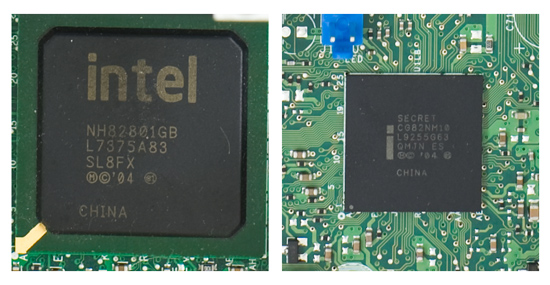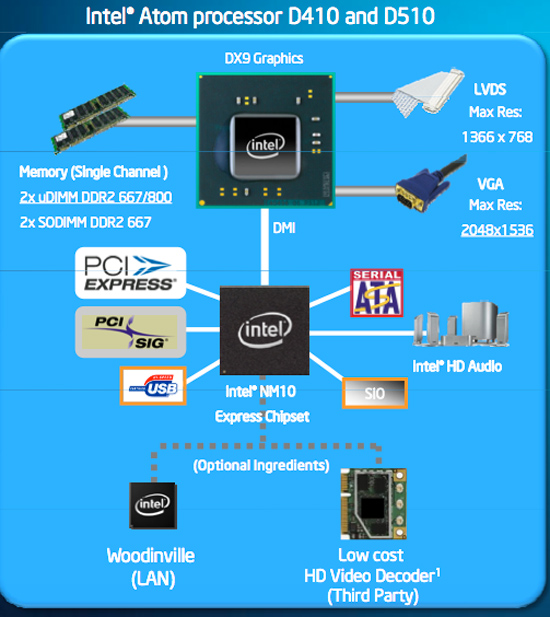Intel Atom D510: Pine Trail Boosts Performance, Cuts Power
by Anand Lal Shimpi on December 21, 2009 12:01 AM EST- Posted in
- CPUs
No Native Hardware H.264 Decoding: Long Live Ion
The integrated GMA 3150 graphics hasn’t been used by Intel before, it’s a 45nm shrink of the GMA 3100. It’s technically a DX9 GPU running at 400MHz, however as you’ll soon see - you can’t really play any games on this platform. The GPU only offers hardware acceleration for MPEG-2 video, H.264 and VC-1 aren’t accelerated.

Max output resolution is also limited. The best you can get over a digital connection (HDMI/DVI) is 1366 x 768, over analog VGA you can do 2048 x 1536 (only 1400 x 1050 on the N450). It’s a curious coincidence, Poulsbo also had a 1366 x 768 digital output limitation.

Dual-core Atom "Pineview", the left half are the two CPU cores, the right portion is GPU + memory interface
And now we see why Intel skimped on the GPU abilities: nearly half the die is used for graphics.

Single-core Atom "Pineview"
On the single core part, more than half the die is the GPU/memory controller. At 32nm this won’t be a problem, but today at 45nm it is what it is - we get a mediocre GPU.
The NM10 Express Chipset
Pine Trail is all about integration. Pulling the memory controller and GPU on-die let board makers either build smaller, simpler or more feature rich motherboards. In fact, one of the benefits of integration is that all Atom motherboards can now be built using 4 layer PCBs. Previously, only the desktop Atom boards could be built on 4 layer PCBs, now netbook boards can be just as cost effective.

The old ICH7 (left) vs. the new NM10 (right) - pictures are to scale, the NM10 is really that much smaller
With the memory controller and GPU on-die, the “chipset” in Pine Trail has been reduced to a single chip external to the CPU. It’s called the NM10 Express Chipset and it connects to the new Atom CPU via a 2.5GB/s DMI link.
Intel’s NM10 supports 8 USB 2.0 ports, two SATA ports, HD audio, 2 x 32-bit PCI slots and 4 PCIe lanes. The NM10 is derived from existing ICH technologies, but bundled in a smaller package for use in small form factor motherboards.
Intel lists one interesting “optional ingredient” that can be connected to the NM10 chipset: a third party HD video decoder.

The FTC hasn’t won it’s case yet so most manufacturers still prefer to support Intel and would rather pair Pine Trail with a Broadcom H.264 decoder than go for something like Ion. It’s Intel’s concession to those who demand high definition video acceleration. Honestly, I would’ve preferred to see something that could do it natively instead of relying on a 3rd party solution. I suspect that the 3rd generation of Atom will solve this; at 32nm there’s more than enough transistor budget to integrate a GMA4500 series core, which would finally bring Atom up to feature parity with NVIDIA’s Ion chipset...just two years later
What About Ion 2?
Pine Trail uses Intel’s DMI to connect Pineview and the NM10 chipset. NVIDIA doesn’t have Intel’s blessing to sell chipsets that use DMI, so NVIDIA can’t produce something that takes the place of the NM10 chip.
NM10, however, has an integrated PCIe controller. It’s possible that NVIDIA’s next-generation Ion will simply connect via PCIe to the NM10 chip.










41 Comments
View All Comments
yuhong - Wednesday, December 30, 2009 - link
"Granted the board only costs $75 new, but would it have killed Intel to include DVI or HDMI out?"That is a limitation of the on-die GPU, it only support VGA and LVDS for the display.
lucaiuli - Saturday, January 2, 2010 - link
Found this board at http://www.mini-box.com/D510MO-mini-ITX-Intel">http://www.mini-box.com/D510MO-mini-ITX-Intel, it will be available this week, price is not bad. I am considering buying one and with a Broadcom Crystal HD miniPCI Express card and proper miniITX enclosure it would be a nice fanless and siled HD HTPC for my living room.geok1ng - Tuesday, December 22, 2009 - link
"It’s not a problem in areas where AMD is competitive, but what about areas in which they’re not?"AMD chose not to be competitive on the Netbook and lower power notebook market. There was a time when ATIs IGPs were very good, and today an overclocked 3200 can dish out enough fps to compete with NVIDIAs offerings. AMD had a lower power CPU months before the CLUVs, but it never become an integrated platform like Ion, even on the micro HTPC market.
If a company has a super IGP, and there was a time when AMD had one, and the market has a new wave of low power low costs Netbooks, and this company decides not to join the wave, well, dont blame Intel when things go the way of the Dodo.
I am only seeing Intel paying AMD so that Intel remains dominating the market, even on produtcs were Intel's offerings are so crappy as the IGP market.
Penti - Tuesday, December 22, 2009 - link
AMD still offers the AMD Neo X2 with AMD 785G or HD4200 graphics or with embedded AMD 780E + SB710 chipset. But that's not a netbook offering but a consumer or ultra-portable low-power notebook offer. I don't really like it that it's K8 based but it's still not totally bad. I don't think AMD is interested in the MID/smartphone market Intel is going after slowly any way.There's reason the AMD Neo platform didn't become a HTPC platform, first it was only released with 690E, secondly it wasn't supported in XBMC on linux. Then there's cost. Now CULV makes a lot more sense. GMA4500 is good enough. And it's first now supports really is coming through with Flash acceleration etc. It was a very limited usability with such a platform before. So soon Atom (with Broadcom accelerator), CULV etc really becomes useful and functional in the consumer space. AMD don't have any advantages even if they have support for the same things. I think it's wise that they are designing wholly new mobile products. Then there's gonna be a fair fight. Products will have a lower power envelope and be cheaper and on newer node. More will be released into the market.
killerclick - Monday, December 21, 2009 - link
This could be a chance for VIA Nano to get in on the netbook market. I fear however that most people buying netbooks won't know or care about the difference between the platforms. If it's cheap and can at least play 720p they won't go out of their way to get something non-Intel.Penti - Tuesday, December 22, 2009 - link
I won't consider the Nano until they have shrunk it, made it less power hungry, made it dual core and released a good graphics chip with truly open source drivers. I'd rather have Pineview + Broadcom BCM70015 if not.It's impressive what Centaur can do with ~100 employees, but I'm not impressed with the S3 Graphics or VIA chipset team.
killerclick - Tuesday, December 22, 2009 - link
I meant Nano + ATI/NVIDIA IGPPenti - Tuesday, December 22, 2009 - link
Yeah I know you wrote that. But..That will never happen. It's Nano + Mobile ATI/NVIDIA GPU tops. But I don't see the point. Via's own gpus are fine for DXVA in Windows etc. Nano aren't that power efficient to begin with. It's not like such platforms will be fast enough to game on either way.
This is what they have coming out (chipset with IGP) http://via.com.tw/en/products/chipsets/v-series/vn...">http://via.com.tw/en/products/chipsets/v-series/vn... It's not that bad. It has modern integrated graphics but it can be used with a discrete graphics solution too.
strikeback03 - Monday, December 21, 2009 - link
If I remember correctly, you used a standard ATX power supply for testing the LF/LF2 Atom boards, which you speculated was part of the reason for such high power consumption. Did you restest with the same PSU as from the Pine Trail system?Griswold - Monday, December 21, 2009 - link
Almost no performance gains - the opposite is actually true with the demise of useful chipset graphics for the atom platform.Buh bye, atom! Hello VIA Nano + ION!